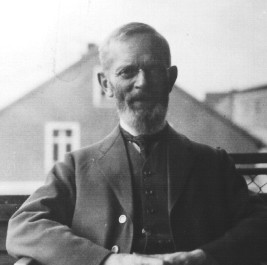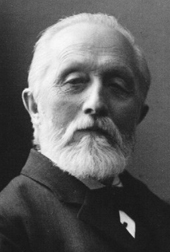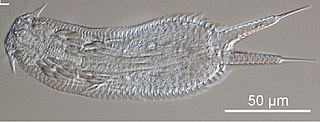| Dasydytidae | |
|---|---|
| Scientific classification | |
| Kingdom: | Animalia |
| Phylum: | Gastrotricha |
| Order: | Chaetonotida |
| Suborder: | Paucitubulatina |
| Family: | Dasydytidae von Daday, 1905 [1] |
Dasydytidae is a family of gastrotrichs in the order Chaetonotida.
| Dasydytidae | |
|---|---|
| Scientific classification | |
| Kingdom: | Animalia |
| Phylum: | Gastrotricha |
| Order: | Chaetonotida |
| Suborder: | Paucitubulatina |
| Family: | Dasydytidae von Daday, 1905 [1] |
Dasydytidae is a family of gastrotrichs in the order Chaetonotida.

Karl Hermann Johannes Thiele was a German zoologist specialized in malacology. Thiele was born in Goldap, East Prussia. His Handbuch der systematischen Weichtierkunde is a standard work. From 1904 until his retirement in 1925 he was the curator of the malacological collection at the Museum für Naturkunde in Berlin. Thiele described more than 1.500 new species of molluscs; until today their types are deposited with the Museum of Natural History in Berlin. Especially important are his works on the Mollusca of the First German Antarctica Expedition and of the German Deep Sea Expedition aboard the vessel Valdivia.

Heinrich Georg Bronn was a German geologist and paleontologist. He was the first to translate Charles Darwin's On the Origin of Species into German in 1860, although not without introducing his own interpretations, as also a chapter critiquing the work.

Janenschia is a large herbivorous sauropod dinosaur from the Late Jurassic Tendaguru Formation of Lindi Region, Tanzania around 155 million years ago.

Oswald Duda, full name Pavel Theodor Friedrich Oswald Duda was a German entomologist mainly interested in Diptera.

Theodor Becker was a Danish-born German civil engineer and entomologist primarily known for studies on the taxonomy of flies.

Oscar Rudolph Neumann was a German ornithologist and naturalist who explored and collected specimens in Africa. He fled via Cuba and settled in the United States to escape Nazi persecution of Jews. Neumann's starling and several other species are named after him.
Halticosaurus (pron.:"HAL-tick-oh-SORE-us") is a dubious genus of theropod dinosaur from the late Triassic period. It is known from a single fragmentary fossil specimen of the species H. longotarsus, found in the Middle Stubensandstein formation of what is present-day Germany The only known specimen was poorly preserved and may have been put together from bones of unrelated animals. Further research would be required to determine which of the bones belonged together, and what kind of theropod Halticosaurus was. However, most of the bones have been lost. For these reasons, Halticosaurus is considered to be a nomen dubium.
Johann Dietrich Alfken was a German entomologist who specialised in Hymenoptera especially Apoidea.

Echinostomata is a suborder of the parasitic flatworm order Plagiorchiida. The suborder contains numerous species that are parasitic in humans.
Baryplegma is a genus of tephritid or fruit flies in the family Tephritidae.

Urophora is a genus of tephritid or fruit flies in the family Tephritidae.

Trupanea is a genus of tephritid or fruit flies in the family Tephritidae.

Peter Jörgensen was a Danish early 20th century entomologist, active particularly in Argentina and Paraguay.

Karl Matthias Friedrich Magnus Kraepelin was a German naturalist who specialised in the study of scorpions, centipedes, spiders and solfugids, and was noted for his monograph Scorpiones und Pedipalpi (Berlin) in 1899, which was an exhaustive survey of the taxonomy of the Order Scorpiones. From 1889 to 1914, he served as the Director of the Naturhistorisches Museum Hamburg, which was destroyed during World War II, and worked on myriapods from 1901 to 1916.

Paucitubulatina is a suborder of gastrotrichs in the order Chaetonotida.

Chaetonotidae is a family of gastrotrichs in the order Chaetonotida. It is the largest family of gastrotrichs with almost 400 species, some of which are marine and some freshwater. Current classification is largely based on shape and external structures but these are highly variable. Molecular studies show a high level of support for a clade containing Dasydytidae nested within Chaetonotidae.

Carl Ludwig Patsch, also Karl Ludwig Patsch, Albanian: Karl Paç; Bulgarian: Карл Пач was an Austrian Slavist, Albanologist, archaeologist and historian.
The Luritja or Loritja people, also known as Kukatja or Kukatja-Luritja, are an Aboriginal Australian people of the Northern Territory. Their traditional lands are immediately west of the Derwent River, that forms a frontier with the Arrernte people, with their lands covering some 27,000 square kilometres (10,300 sq mi). Their language is the Luritja dialect, a Western Desert language.
Neodasys is a genus of gastrotrichs in the class Chaetonotida. It is the only genus in the family Neodasyidae, which is the only family in the suborder Multitubulatina.